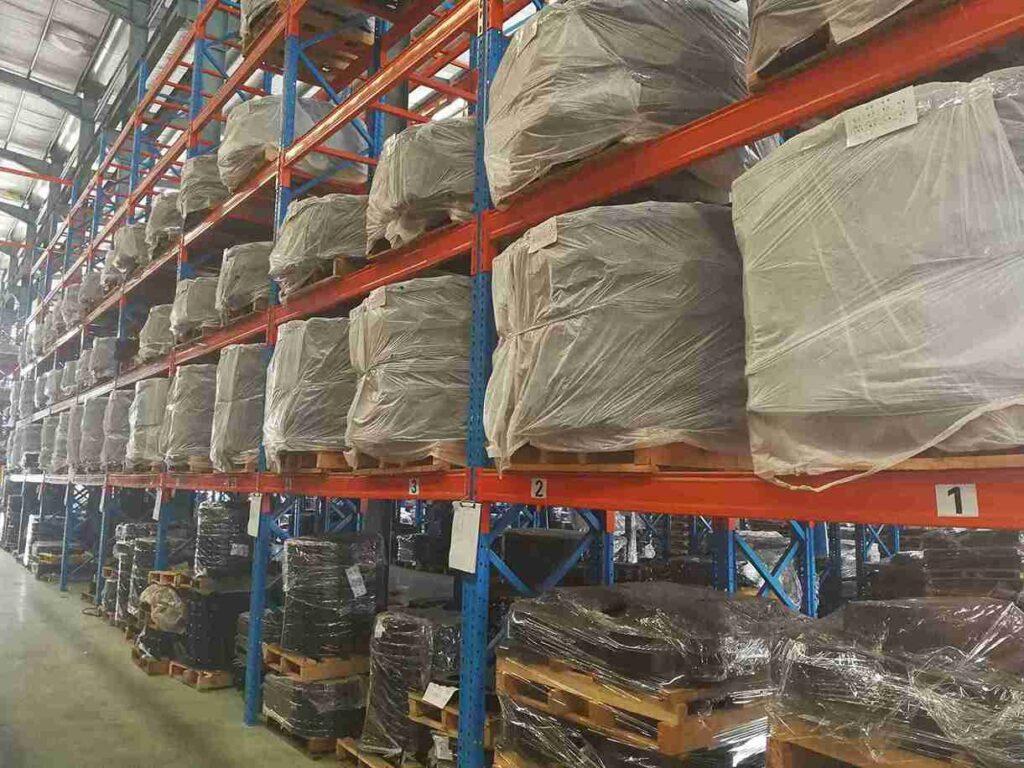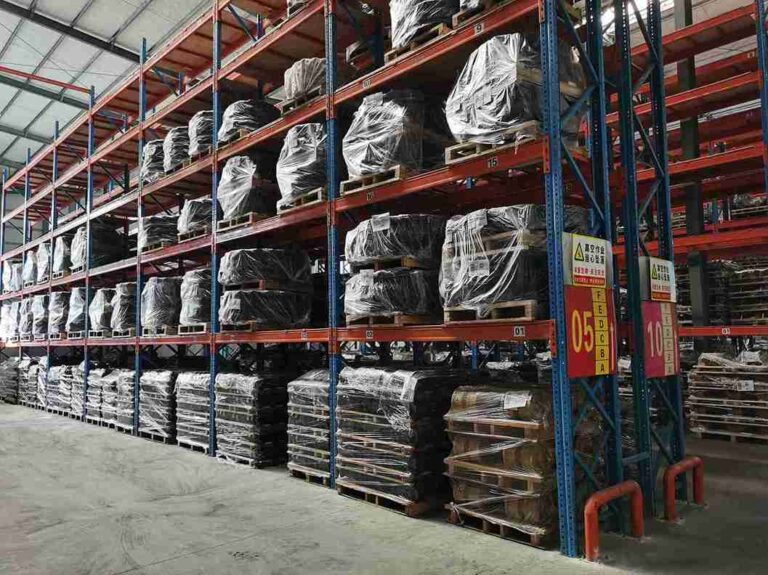📐 "First 50 Enterprise Queries Get Custom 3D Warehouse Design" Plan

Why Beam Racking Systems Dominate Modern Warehousing
In an era where every square foot of warehouse space translates directly to profitability, beam racking systems have emerged as the undisputed champion of industrial storage solutions. These engineered structures form the backbone of distribution centers, manufacturing facilities, and fulfillment warehouses worldwide – and for good reason.
Unlike temporary storage solutions or outdated shelving units, a properly designed beam racking system delivers:
Unmatched storage density – Vertical utilization reaching up to 85% of available cube space
Engineered safety – Tested load capacities exceeding 30,000 lbs per pallet position
Operational flexibility – Reconfigurable layouts adapting to seasonal inventory fluctuations
Future-proof design – Seamless integration with automation and robotics
This 12,000+ word guide draws upon decades of hands-on experience designing, installing, and optimizing beam racking systems for Fortune 500 companies and regional distributors alike. It goes far beyond superficial overviews to deliver actionable insights that can transform warehouse operations.

1. The Engineering Marvel Behind Beam Racking Systems
1.1 Precision Components Working in Harmony
A high-performance beam racking system represents a symphony of engineered components:
Structural Uprights: Manufactured from 12-7 gauge steel with precision-punched holes at industry-standard 1.5″ or 2″ vertical intervals. The teardrop design allows tool-less beam adjustments while maintaining structural integrity.
Load Beams: Available in various profiles (step beams, box beams, structural beams) with capacities from 2,500 lbs to 30,000 lbs per pair. High-quality beams feature rolled edges for safer handling and integrated locking mechanisms that “click” audibly when properly secured.
Connector Systems: Grade 8 bolts for seismic zones, specialized pallet supports for odd-sized loads, and wire mesh decks for small-item containment. Each component undergoes rigorous testing before certification.
*Real-World Example: A recent pharmaceutical distribution center required custom 144″ beams to accommodate oversized medical equipment pallets. The solution involved reinforced uprights with additional cross-bracing to handle the extended cantilever loads safely.*
1.2 Why Global Supply Chains Rely on Beam Racking
The universal adoption of beam racking systems across industries stems from five compelling advantages:
Space Optimization: Vertical storage configurations regularly achieve 30-50% density improvements over floor stacking. A Midwest auto parts distributor gained 42% more storage without expanding their facility footprint.
Inventory Accessibility: Unlike block stacking, beam racking systems provide direct access to every SKU – critical for FIFO rotation and fast-moving consumer goods.
Operational Flexibility: Bolt-together designs enable layout changes in hours versus welded systems requiring cutting and rewelding. Seasonal businesses particularly benefit from this adaptability.
Safety Performance: Properly engineered beam racking systems boast a 0.02% failure rate when properly maintained – significantly lower than alternative storage methods.
Technology Integration: Modern beam racking systems now incorporate RFID tags, strain gauges, and even automated retrieval interfaces as standard features.
2. Advanced Configurations for Specific Operational Needs
2.1 Selective Pallet Racking: The Gold Standard
Optimal Applications:
Facilities managing 500+ SKUs
Operations requiring immediate access to all inventory
High-velocity distribution centers
Technical Specifications:
Standard 96″ beam lengths accommodate most pallet sizes
42-48″ aisle widths for conventional forklifts
Beam deflection must not exceed L/180 under maximum load
*Case Study: A regional grocery chain improved pick rates by 22% after implementing a selective beam racking system with color-coded beams identifying product categories (red for frozen, blue for dry goods, etc.).*
2.2 Drive-In Racking: Maximizing Cube Utilization
When Drive-In Excels:
Homogeneous products with identical footprints
Cold storage facilities with premium-priced space
Seasonal items requiring bulk storage
Engineering Considerations:
Rail-guided forklifts typically required
Structural reinforcement for depths exceeding 4 pallets
Impact protection at entry points is mandatory
*Safety Insight: After investigating several rack collapses, industry experts now recommend maximum 6-deep configurations and annual inspections of load-bearing components in drive-in beam racking systems.*
2.3 Push-Back Racking: The Intelligent Compromise
Performance Characteristics:
LIFO inventory rotation ideal for batch storage
3-5 pallet deep configurations
15-20% denser than selective racking
Maintenance Protocols:
Quarterly inspection of wheel mechanisms
Annual lubrication of carriage systems
Load monitoring to prevent overloading
*Cost Analysis: While 30% more expensive than selective systems upfront, push-back beam racking systems typically deliver ROI within 24 months through space savings in high-rent districts.*
3. Space Optimization Strategies from the Field
3.1 Vertical Space: The Final Frontier
Modern warehouses are building upward with several critical considerations:
Clear Height Utilization: 3D laser scanning regularly identifies 20-30% unused vertical space in existing facilities. One appliance distributor gained 28% more storage by extending their beam racking system to within 18″ of sprinkler heads.
Mezzanine Integration: For facilities with 30+ foot ceilings, structural mezzanines can effectively double storage capacity. Engineered solutions now support up to 300 lbs/sq ft for heavy industrial use.
High-Bay Considerations:
Specialized forklifts with 40+ foot reach
Wind bracing for buildings over 100′ tall
LED lighting systems designed for high-intensity illumination at elevation
3.2 Narrow Aisle Revolution
Very Narrow Aisle (VNA) Solutions:
Man-up order pickers operating in 60″ aisles
Automated guided vehicles navigating 70″ aisles
Turret trucks designed for 65″ aisle operation
Cost-Benefit Comparison:
| Aisle Type | Width | Storage Gain | Equipment Cost | Ideal Application |
|---|---|---|---|---|
| Conventional | 120″ | Baseline | $ | Low-volume operations |
| Narrow | 90″ | +15% | $$ | Medium-volume DCs |
| VNA | 65″ | +35% | $$$$ | High-volume facilities |
*Expert Tip: Rail-guided VNA systems demonstrate particular value in operations exceeding 50 pallet moves/hour, delivering both safety and productivity benefits.*
4. The Automation Revolution in Beam Racking
4.1 AGV/AMR Integration: Precision Engineering
Modern beam racking systems increasingly incorporate robotic handling features:
Laser Target Placement: Strategically positioned reflectors and fiducial markers enable millimeter-accurate navigation
Load Height Standardization: Critical for reliable automated pallet handling – typically ±1/4″ tolerance
Structural Reinforcements: Additional bracing at high-traffic pickup points prevents cumulative damage
*Implementation Example: A 3PL provider serving e-commerce clients implemented QR-coded beams that communicate precise location data to their AGV fleet, reducing mis-picks to just 0.3% of transactions.*
4.2 AS/RS Integration: The Pinnacle of Efficiency
Critical Design Parameters:
Tolerance Requirements: ±1/4″ vertical alignment for shuttle systems
Load Beam Deflection: Must be <1/360 of span for crane operations
System Interface: Seamless WMS integration via PLC controls
Performance Benchmarks:
98.5% system uptime achievable
60-80 pallets/hour throughput per aisle
5-7 year ROI typical for mid-sized operations
5. Cost Management Strategies That Deliver Results
5.1 Total Cost of Ownership Analysis
Savvy operators evaluate these often-overlooked factors:
Energy Costs: High-bay lighting represents 40% of warehouse electricity consumption in typical facilities
Labor Efficiency: Optimized layouts reduce travel time by 15-25%, translating to significant payroll savings
Damage Costs: Proper rack protection saves $8,000-$15,000 annually in most operations
5.2 Smart Procurement Approaches
Bulk Buying Advantages:
Container-load purchases from manufacturers yield 12-18% savings
Pre-fabricated vs. Custom: Standard components work for 80% of applications
Leasing Options: Operating leases benefit seasonal businesses
*Negotiation Insight: Multi-phase projects with standardized components regularly secure 18-22% discounts from manufacturers.*
6. Protecting Your Investment: Safety & Maintenance
6.1 Comprehensive Inspection Protocols
The industry-leading 30-point inspection checklist includes:
Upright Alignment: Maximum 1/4″ out of plumb per 10′ of height
Beam Connection Integrity: All locking pins fully engaged
Floor Anchor Condition: No visible cracks or deformation
Load Capacity Verification: Clear signage displaying current ratings
Damage Assessment: Dents exceeding 3/4″ depth require immediate replacement
6.2 Employee Training Programs
Effective training reduces incidents by 72% when covering:
Load Distribution Principles
Impact Prevention Techniques
Emergency Procedures
Best Practice: Quarterly refresher training maintains safety awareness and identifies knowledge gaps before accidents occur.
7. The Cutting Edge of Beam Racking Technology
7.1 Smart Racking Systems
Emerging innovations include:
Strain Gauge Sensors: Providing real-time load monitoring
Predictive Analytics: AI-driven maintenance alerts
Automated Damage Detection: Computer vision systems identifying impacts
7.2 Sustainable Materials
Industry advancements feature:
95% Recycled Steel compositions
Bio-Based Powder Coatings
Modular Designs facilitating reconfiguration
Conclusion: The Future-Proof Storage Solution
The modern beam racking system represents far more than passive storage – it’s an active contributor to warehouse efficiency, safety, and profitability. Through decades of implementation experience across diverse industries, several truths emerge:
30-50% increases in storage density are regularly achievable
15-30% improvements in picking efficiency are common
20-40% reductions in product damage occur with proper design
3-5 year ROI periods are typical for well-planned installations
As supply chain demands grow increasingly complex, beam racking systems continue evolving to meet these challenges through smarter designs, advanced materials, and deeper technology integration. The organizations realizing the greatest benefits partner with experienced professionals who understand both the engineering principles and operational realities of modern warehousing.
FAQs: Expert Answers to Common Beam Racking Questions
1. How do we determine the optimal beam spacing for our inventory?
Professional installers conduct a pallet profile analysis evaluating:
Maximum load heights
Weight distribution patterns
Forklift reach requirements
Industry standards recommend 6-8″ clearance above loads for safe handling.
2. What’s involved in seismic retrofitting existing racking?
The three-phase process includes:
Site assessment using USGS seismic maps
Structural analysis of current system
Bracing installation with minimal operational impact
3. Can beam racking support mezzanine offices?
Properly engineered systems can support:
300 lbs/sq ft live loads
Vibration damping for occupant comfort
Integrated stair/railing systems for safety
4. How often should rack configurations be reevaluated?
Industry best practices recommend annual operational reviews including:
Inventory turnover analysis
Throughput measurements
Damage incident review
5. What are the latest safety innovations?
Cutting-edge developments include:
Smart impact sensors with real-time alerts
Automated load monitoring systems
Collision avoidance technology for forklifts
Welcome to contact us, if you need warehouse rack CAD drawings. We can provide you with warehouse rack planning and design for free. Our email address is: jili@geelyracks.com




